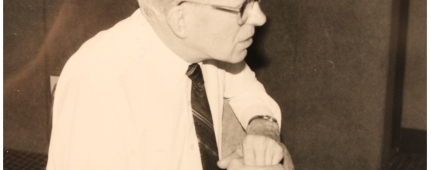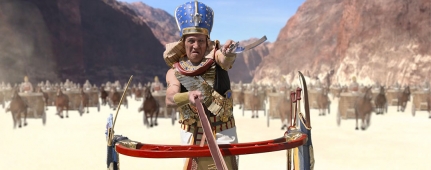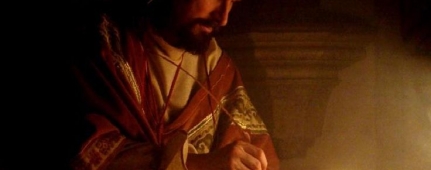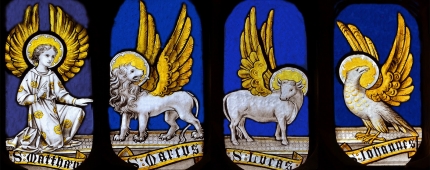Hebrews 9:3–4—Was the altar of incense in the Holy Place or in the Most Holy Place behind the veil?
Problem: According to Exodus 30:6 (cf. 26:33; 40:3), the altar of incense was in the Holy Place in front of the veil, not in the Most Holy Place behind the veil. However, Hebrews 9:3–4 states that it was “behind the ... veil, [in] the part of the tabernacle which is called the Holiest of all.”
Solution: Several possible solutions have been suggested to this difficulty. Any one of them would resolve the problem.
1. The text has been corrupted by a copyist mistake. Some scholars note that there is a possible textual dislocation here, that the phrase about the “golden altar” (v. 4) really belongs in verse 2 along with the other furniture in the Holy Place. This they note is the way it is in some early manuscripts, such as, Vaticanus (a.d. 4th century), the Coptic, and the Ethiopic versions.
Others object that the overwhelming textual evidence and virtually all modern translations oppose these isolated exceptions. They further note that the few texts which disagree leave the impression that they result from an attempt to “correct” the text which they found difficult to understand.
2. The altar was inside the veil. Following Hebrews 9:3–4, it has been argued that the Altar of Incense was always inside the Most Holy Place. This view is supported with the following arguments. First, it is in accord with the clear statement in Hebrews 9:3–4. Second, it is implied in other passages which speak of this altar as “before the ark of the testimony” (Ex. 40:5), which was in the Most Holy Place. Third, 1 Kings 6:20 speaks of the altar of incense as “belonging to the inner sanctuary” (Phillip E. Hughes translation).
Opponents of this view have noted several objections. First, it is contrary to clear statements in the OT (e.g., Ex. 30:10) that place the altar of incense in the Holy Place, along with the bread and the candles. The priest, who was forbidden to enter the Most Holy Place (except on the Day of Atonement), served at the altar of incense daily (Ex. 30:6–11). Second, Philo, Josephus, and other Jewish authorities all placed it outside the veil in the Holy Place. Finally, the NT locates it outside the veil where ordinary priests like Zechariah ministered (Luke 1:5ff).
3. The Veil was moved on the Day of Atonement. According to this position, the altar of incense was usually stationed outside the veil in the Holy Place. However, they believe the veil was moved back on the Day of Atonement so the priest could have ready access to the altar of incense in order to use it in the Most Holy Place. Support for this view is derived from the following: First, the Bible usually speaks of the altar of incense as being separated from the Most Holy Place by a veil (cf. Ex. 30:6; Lev. 16:12, 15, 17). The only time it speaks of this altar being accessible to the priest in the Most Holy Place is on the Day of Atonement (cf. Lev. 16:2; Heb. 9:7). Finally, this fits with the typology of the OT high priest who did once a year what Christ did once for all time (cf. Heb. 10:10–11), namely pull back the veil that separates us from God. In this connection it is noted that Christ has rent the veil (Matt. 27:5) and there is no longer a separation between the Holy Place and the Most Holy Place.
The main problems with this view are these: First of all, there is no passage that actually states the veil was moved back on the Day of Atonement. Second, it may be pushing a type too far. After all, not everything the OT priest did prefigured Christ. For example, they continued to offer sacrifices after their Day of Atonement (Heb. 10:11); Christ did not after His. Third, there are passages which clearly imply the veil was still in place on the Day of Atonement, speaking of the priest going “inside the veil” to do his work (Lev. 16:12; cf. 15, 17, 23, 27).
4. There were two altars of incense. Some scholars posit two altars to resolve the difficulty, one stationed inside and one outside the veil. This view has the merit of explaining all the data and of avoiding the difficulties of the two previous views.
However, there are major problems with this position. First, there is no reference to two altars of incense in either the OT or NT. Second, Jewish authorities (such as Philo and Josephus) make no reference to any such second altar. Third, if there were two altars, then the author of Hebrews must be charged with a gross omission, since he makes no reference to the altar of incense in the Holy Place, which was a regular daily part of the priestly ministry (Heb. 9:3–4). Finally, this suggested solution seems harmonistic, that is, suggested as a solution without any substantial evidence for it.
5. The golden censer differs from the golden altar. This position contends that the Greek word thumiaterion often translated “golden altar” (Heb. 9:4) should be rendered “golden censer.” This would resolve the difficulty, since the altar of incense would be outside the veil and the golden censer would be inside the veil where the priest could use it on the Day of Atonement. In support of this position the following can be offered: First, “censer” is an acceptable translation of the Greek word thumiaterion, which can mean either the place or the instrument of incense. Second, the same Greek word is used of a censer elsewhere in the Greek translation of the OT (cf. Ezek. 8:11; 2 Chron. 26:19). Third, this view is supported by the Jewish Mishnah which gives a detailed description of this golden censer. Fourth, it avoids a flat contradiction which involves having one altar in two places. Fifth, it fits with the fact that the altar of incense is usually mentioned with the bread and candles (which are always in the Holy Place), whereas the golden censer is used only once a year in the Most Holy Place (Lev. 16:2, 12, 29). Sixth, Aaron the high priest was expressly commanded to burn incense in a censer before the mercy seat on the Day of Atonement (Lev. 16:12–13). Seventh, as a Jewish teacher familiar with the law, the author of Hebrews would have been familiar with the temple furniture and ritual. Eighth, his message would have had no credibility with his Hebrew readers had he made a gross mistake in the positioning of the altar of incense. Ninth, since this instrument for incense was used only once a year in the Most Holy Place, it is only reasonable that it would be kept in the most sacred place.
As much as there is to commend it, this view is not without objections. First of all, the Greek word in question is usually translated “golden altar” (e.g., asv, nasb, rsv, niv, nkjv), not a “golden censer.” Second, if it is translated “golden censer,” then the author of Hebrews must be charged with a gross omission of the altar of incense, which seems unlikely given its importance in the tabernacle furniture and daily ministry. Third, if “censer” was meant it would not have been made of gold but of brass to house the hot coals for the incense. Finally, the same term is used by contemporary Jewish authorities (Philo and Josephus) to refer to the altar of incense.
6. The altar of incense was moved on the Day of Atonement. Other scholars affirm that Hebrews 9:3–4 is a reference to the “golden altar” of incense which was moved from its regular location outside the veil on the special occasion of the Day of Atonement. There are several arguments in favor of this view. First, it resolves the apparent conflict by holding that there was only one ark which is located in two different places at the appropriate times. Second, it explains all the data consistently. Third, it avoids the speculative nature of the two altar theory. Fourth, it seems inconceivable that the author of Hebrews, writing to Hebrew Christians familiar with the facts, would place such an important item of tabernacle furniture in the wrong place. This view avoids such an unlikely situation. Fifth, it explains how the high priest could have used this altar so readily in cleansing the Most Holy Place on the Day of Atonement, since it was moved there on that occasion. Sixth, it fits with the other references of Scripture which speak of incense being offered in the very presence of a holy God (Rev. 8:3; 9:13). Seventh, it is congruent with 1 Kings 6:22 which can be rendered, “the entire altar [of incense] ... was in the inner sanctuary.” Eighth, Exodus 30:6 (cf. 40:5) may be instructions to move the altar of incense to the Most Holy Place on the Day of Atonement. Likewise, Hebrews 9:6 may encompass this move when it says, “now when these things had been thus prepared.” Ninth, the Jewish Apocalypse of Baruch (6.7), which belongs to this same period, describes the Most Holy Place as containing the altar of incense.
It has been suggested that the lack of explicit reference to moving the altar of incense for the Day of atonement makes this view problematic. Likewise, some have queried how the high priest could have moved this heavy altar by himself. But neither of these is telling arguments, since not everything is explicitly noted in Scripture and the other priests were available to make any arrangements necessary for the Day of Atonement.
7. The altar was “inside” by doctrinal association. Some Bible students have suggested that the altar of incense was actually located outside the veil but that it was listed as “inside” in Hebrews 9:3–4 because of its close association with the ark of the covenant and the atoning sacrifice offered there. In brief, Hebrews is speaking of it being “inside” by doctrinal association but not in its spatial location. In support of this conclusion they cite the fact that the author of Hebrews uses the participle “having” (echousa) instead of the expression “in which” (en he) which would clearly mean spatial location.
This view, of course, would solve many of the problems associated with other views, but it creates problems of its own. First of all, the same word (echousa) translated “having” is used spatially in this very passage (cf. v. 4). Furthermore, the two phrases are used interchangeably in this text, indicating that it is more a matter of variation in style than a desire to give a non-spatial relational impression.
In summary, while any one of these views is possible and would remove the difficulty, some seem unlikely (1 and 7). Others seem more probable (5 and 6). Whichever is correct, there is certainly no demonstrated error here in the Bible. On the contrary, several plausible solutions are available.
See All Problems
This excerpt is from When Critics Ask: A Popular Handbook on Bible Difficulties (Wheaton, Ill.: Victor Books, 1992). © 2014 Norman Geisler and Thomas Howe. All rights reserved. Used by permission. Click here to purchase this book.














